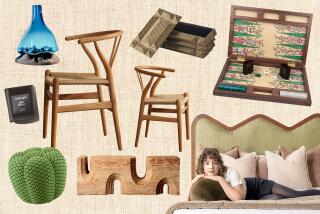Fashion Gets the Dragonfly Bug :...
- Share via
Dragonflies are the insect of the year. Dresses, shoes and jewelry feature the distinctive-looking bug. Many types of insects have been believed to have magical powers. The butterfly was a symbol of immortality, longevity, rebirth and even protection from decay. The dragonfly was thought to have powers of immortality and regeneration, but also courage, bravery and swiftness.
Dragonfly fossils are known to date back 300 million years, and they are among the oldest known insects. The speed of the dragonfly’s wings impressed the American Indians, who thought the insect represented speed and agility.
Some Plains Indians used the dragonfly image on clothing, and the Navajo and Zuni used it in jewelry. Dragonfly jewelry was very popular in the 1880s-1900s. Art Nouveau artists particularly liked the shape of the wings and often replaced the body with that of a woman.
*
Question: When we cleaned out my grandmother’s house, we found an old, heavy wrought-iron plant stand. How long have iron plant stands been made?
*
Answer: Wrought iron was used by the eighth century to make tools and weapons. It was used in Europe to make railings, doors, balconies, grilles and other building decorations before the Middle Ages. Wrought-iron, cast-iron and bent-wire plant stands were not made until the 19th century, when Americans started importing showy plants and building household conservatories.
*
Q I have four American pressed-glass goblets made in the Westward-Ho pattern. Two are clear glass with frosted decoration, one is all clear, and the fourth is green. I found the frosted goblets in a book on pressed glass, but I can’t find anything on the clear or blue-green glasses. Can you help, and also tell me what they are worth?
*
A Westward-Ho is a well-known pressed-glass pattern. It was first produced in the mid- to late-1870s by Gillinder and Sons of Philadelphia. It also happens to be a pattern that many companies reproduced.
The original pieces are clear with an acid-finished (frosted) design in high relief picturing a buffalo, deer and a log cabin. Reproductions by the Westmoreland Glass Co. of Grapeville, Pa., and by the L.G. Wright Glass Co. of New Martinsville, W.Va., started appearing in the 1930s.
They look like the originals and may have been made from original molds. An expert could determine that a reproduction’s frosting is whiter and the surface rougher, but it’s hard for the average collector to tell the difference.
Examine the deer and buffalo on your frosted glasses. The deer’s mouth should be straight and closed. The hair on both animals should be distinctly visible. The deer on reproduced goblets has a blurry mouth, and both animals have almost no visible hairs.
Goblets that are clear, amberina, blue or green are reproductions, and most date from the 1950s. Original goblets sell from $75 to $150. Clear-and-frosted reproductions sell for about $60 each. A clear glass or color reproduction sells for $20 to $30.
*
Q I just bought a large piece of cloth printed with the picture of a 24-inch doll on the front and back.
The directions printed on the fabric tell how to cut the squares apart and stitch them into the doll. It reads “Dolly Dear, Saalfield Publishing Company N.Y., 1916” on the fabric.
Can you tell me about it?
*
A Stuffed fabric dolls were very popular at the turn of the century. The fabric printed with the doll and instructions was sold to those who made finished toys for their children.
Dolly Dear was drawn by a famous illustrator, Frances Brundage (1854-1937). She illustrated more than 240 books and also did drawings for calendars, trade cards, postcards, valentines, paper and cloth dolls and prints.
She is best known for paintings of Victorian children. Uncut fabric dolls are difficult to find, and they sell from $150 to $300 each.
*
Q My white china platter, 9 by 13 inches, is decorated with two large and three small bluebirds. The mark on the back reads “KT&K;/S------V/China.”
Can you tell me when my platter was made and what it’s worth?
*
A Your plate was made by Knowles, Taylor and Knowles of East Liverpool, Ohio. The company worked from about 1854 to 1929. Early in this century it was the largest dinnerware manufacturer in the United States.
Knowles, Taylor and Knowles made hotel china and dinnerware. The bluebird pattern was very popular and was sold by stores like Sears, Roebuck and Co.
Your platter is worth close to $100.
For a listing of helpful books and publications, include a self-addressed, stamped (55 cents) envelope to Kovels, Los Angeles Times, King Features Syndicate, 235 E. 45th St., New York, NY 10017.






